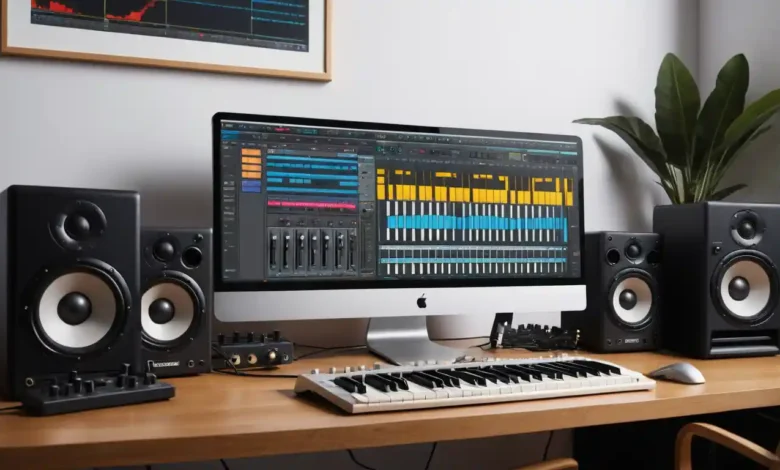What Is Music Technology and Its Impact on Modern Music

In today’s rapidly evolving world, almost every aspect of our lives is being influenced by technology. From smartphones to self-driving cars, the advancement of technology has touched every corner of society and the music industry is no exception. What is music technology and how is it reshaping the way we experience sound? This is a question that increasingly more people are asking as technology continues to play an ever-bigger role in the production, distribution, and enjoyment of music.
Whether you are an aspiring musician, a student of sound engineering, or just someone who loves music, understanding how technology is revolutionizing the way we make and consume music can give you valuable insights. In this blog post, we’ll explore the concept of what is music technology, its various components, and how it’s changing the landscape of modern music.
What Is Music Technology?
At its core, what is music technology refers to the use of electronic devices, software, and digital tools to produce, record, modify, and perform music. This broad field encompasses everything from synthesizers and recording software to digital audio workstations (DAWs) and sound processing tools. As technology has advanced, so has the range of options available to musicians and producers, allowing them to create more complex and innovative sounds than ever before.
The integration of music and technology isn’t new — the introduction of the phonograph and electric guitar, for example, significantly transformed music in the past century. But with the rapid development of digital tools and platforms in recent years, the landscape of music technology has changed dramatically.
The Evolution of Music Technology
To truly understand what is music technology, it’s important to look at its evolution over the years. The advancements in music production have enabled musicians to experiment with sounds and effects, often creating music that was once unimaginable. Here’s a quick rundown of the major milestones in the development of music technology:
The Phonograph (1877): Thomas Edison’s invention marked the beginning of the modern music industry, allowing music to be recorded and played back.
Electric Guitars (1930s): These instruments revolutionized genres like rock and roll and blues, thanks to their ability to produce louder, more dynamic sounds.
Synthesizers (1960s-1970s): Synthesizers allowed musicians to create entirely new sounds by electronically generating audio waves, leading to the rise of genres like electronic music, pop, and new wave.
Digital Audio Workstations (1990s): The rise of DAWs, such as Pro Tools, gave musicians and producers a powerful platform to compose, record, and mix music digitally.
Streaming Platforms (2000s-present): With the rise of streaming services like Spotify, Apple Music, and YouTube, technology has reshaped how music is consumed globally.
Key Components of Music Technology
Music technology is a vast field, and there are several components that make it so dynamic. Understanding these elements will give you a deeper insight into what is music technology and its role in shaping modern music. Some of the key components include:

1. Digital Audio Workstations (DAWs)
A digital audio workstation (DAW) is software used to record, edit, mix, and produce music. Programs like Ableton Live, Logic Pro, and FL Studio have become essential tools for musicians, allowing them to compose music without needing expensive studio equipment. DAWs offer a wide range of virtual instruments and effects that can be customized, making them an integral part of music production today.
2. MIDI and Virtual Instruments
Musical Instrument Digital Interface (MIDI) technology allows electronic devices to communicate with one another. With MIDI, musicians can control virtual instruments, such as synthesizers and drum machines, from a computer keyboard or MIDI controller. This capability has opened up a world of possibilities for music producers, who can now create complex compositions without the need for physical instruments.
Virtual instruments — including virtual pianos, strings, and drums — are software-based and can be integrated into DAWs. They allow producers to replicate the sounds of traditional instruments and explore entirely new sonic possibilities.
3. Sound Engineering and Effects
Sound engineering involves manipulating and shaping sound through various electronic tools and techniques. This can include equalization (EQ), reverb, delay, and distortion. These tools are used to fine-tune the way music sounds, making it more polished or adding creative effects. In modern music production, these tools are vital for achieving the desired sound and enhancing the overall listening experience.
4. Sampling and Looping
Sampling involves taking snippets of existing songs or sounds and reusing them in a new piece of music. This can include a vocal line, a beat, or even a small audio clip. Looping allows producers to repeat these samples, creating complex textures and beats. The art of sampling and looping has given rise to entire genres, including hip-hop, electronic, and pop music.
5. Live Performance Technology
In addition to studio-based music production, technology has also transformed live performances. DJs use controllers and mixers to blend different tracks in real time, while artists use stage effects such as lighting, projection, and sound manipulation to create immersive experiences. The use of technology in live performances allows artists to push the boundaries of what’s possible on stage.
6. Music Distribution and Streaming
Technology has revolutionized the way music is distributed and consumed. In the past, artists had to rely on record labels and physical sales to get their music out to the world. Today, platforms like Spotify, Apple Music, and YouTube allow musicians to distribute their work globally with just a few clicks. The convenience of streaming has made music more accessible, and it has completely transformed the music industry’s revenue model.
Impact of Music Technology on Modern Music
The advent of music technology has significantly altered how music is created, shared, and consumed. Some of the key impacts include:
1. Increased Accessibility and Democratization of Music Production
One of the most notable changes in music production has been the democratization of the process. Thanks to affordable software and hardware, aspiring musicians no longer need to invest in expensive studio equipment to create high-quality tracks. With just a computer, a DAW, and a few basic tools, anyone with a passion for music can start producing their own songs from home. This has led to an explosion of new music across all genres.
2. Creative Freedom and Experimentation
Technology has given musicians more creative freedom than ever before. Artists can experiment with sounds, genres, and styles without being limited by physical instruments or traditional recording processes. For example, electronic music genres like techno, dubstep, and trap could not have emerged without the advancements in music technology. Today, producers can manipulate sound in ways that were previously unimaginable, allowing for the creation of groundbreaking and unique music.
3. Collaboration Across Borders
With online collaboration tools and cloud-based software, musicians from around the world can collaborate in real-time, regardless of their physical location. This has fostered cross-cultural collaborations and allowed for a fusion of different musical styles and traditions. Music technology has truly made the world a smaller place for musicians.
4. Music as a Service
With the rise of streaming platforms, music has become more of a service than a product. Instead of purchasing physical albums or digital downloads, listeners now pay a subscription fee to access millions of songs instantly. This shift has impacted the music industry’s business model, with artists relying more on touring, merchandising, and streaming royalties as their primary sources of income.
Future of Music Technology
Looking ahead, the future of music technology is incredibly exciting. From virtual reality (VR) concerts to AI-generated music, new technologies are constantly emerging that will continue to reshape the music industry. Here are a few trends to watch:

Artificial Intelligence (AI) in Music Production: AI-powered tools are already helping musicians generate melodies, harmonies, and beats. In the future, AI could play a more prominent role in composing entire songs.
Virtual Reality (VR) Concerts: Imagine attending a concert from the comfort of your home but feeling like you’re right there in the crowd. VR could make this a reality, creating immersive concert experiences for fans.
Blockchain and NFTs: These technologies could revolutionize music ownership and distribution, providing artists with more control over their work and creating new opportunities for fans to engage with music.
Frequently Asked Questions
What is music technology and how does it impact music production?
Music technology refers to the use of digital tools, electronic devices, and software to produce, record, and manipulate music. It has transformed the music production process, allowing musicians to create complex compositions, experiment with sounds, and produce music from home studios using digital audio workstations (DAWs), synthesizers, and virtual instruments. This has greatly increased accessibility and creativity in music making.
Can anyone use music technology to create music?
Yes, music technology has become more accessible than ever. With the rise of affordable software and hardware, anyone with a passion for music can create high-quality tracks using just a computer, a DAW, and basic tools. Aspiring musicians no longer need expensive studio equipment, and many platforms offer easy-to-use interfaces for beginners to experiment with music production.
How does music technology enhance live performances?
Music technology enhances live performances by providing musicians with tools to manipulate sound, add effects, and create immersive experiences. DJ controllers, live mixing, projection mapping, and electronic instruments have all become key elements in modern performances, enabling artists to engage audiences with dynamic visuals and sound manipulation in real time.
What role do streaming platforms play in music technology?
Streaming platforms like Spotify, Apple Music, and YouTube are a major part of music technology’s impact on the industry. They allow artists to distribute their music globally with minimal cost, while giving listeners easy access to millions of songs. This shift in distribution has transformed how people consume music, making it more accessible and flexible.
What are the future trends in music technology?
The future of music technology includes exciting trends like the use of artificial intelligence (AI) to assist in music composition, virtual reality (VR) concerts, and the adoption of blockchain technology for music rights and royalties. These innovations will continue to shape the industry, offering new ways for musicians to create, perform, and distribute music in more interactive and personalized ways.
Conclusion
In conclusion, what is music technology? It’s an ever-evolving field that is changing the way we create, share, and experience music. From digital audio workstations to streaming platforms, technology has transformed every facet of the music industry. Whether you’re a musician, producer, or simply a music lover, embracing these technological advancements opens up a world of possibilities.
Are you ready to dive deeper into the world of music technology? Start exploring the tools and software that are shaping the future of music production, and discover how you can be part of the next wave of innovation. The future of music is digital, and it’s waiting for you to make your mark.





